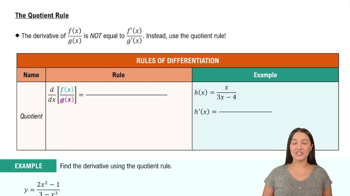Table of contents
- 0. Functions7h 52m
- Introduction to Functions16m
- Piecewise Functions10m
- Properties of Functions9m
- Common Functions1h 8m
- Transformations5m
- Combining Functions27m
- Exponent rules32m
- Exponential Functions28m
- Logarithmic Functions24m
- Properties of Logarithms34m
- Exponential & Logarithmic Equations35m
- Introduction to Trigonometric Functions38m
- Graphs of Trigonometric Functions44m
- Trigonometric Identities47m
- Inverse Trigonometric Functions48m
- 1. Limits and Continuity2h 2m
- 2. Intro to Derivatives1h 33m
- 3. Techniques of Differentiation3h 18m
- 4. Applications of Derivatives2h 38m
- 5. Graphical Applications of Derivatives6h 2m
- 6. Derivatives of Inverse, Exponential, & Logarithmic Functions2h 37m
- 7. Antiderivatives & Indefinite Integrals1h 26m
- 8. Definite Integrals4h 44m
- 9. Graphical Applications of Integrals2h 27m
- 10. Physics Applications of Integrals 2h 22m
6. Derivatives of Inverse, Exponential, & Logarithmic Functions
Logarithmic Differentiation
Problem 3.9.81
Textbook Question
75–86. Logarithmic differentiation Use logarithmic differentiation to evaluate f'(x).
f(x) = (x+1)^3/2(x-4)^5/2 / (5x+3)^2/3
 Verified step by step guidance
Verified step by step guidance1
Step 1: Begin by taking the natural logarithm of both sides of the equation y = (x+1)^(3/2) * (x-4)^(5/2) / (5x+3)^(2/3). This gives us ln(y) = ln((x+1)^(3/2) * (x-4)^(5/2) / (5x+3)^(2/3)).
Step 2: Use the properties of logarithms to simplify the expression. The properties state that ln(a*b) = ln(a) + ln(b) and ln(a/b) = ln(a) - ln(b). Apply these to get ln(y) = (3/2)ln(x+1) + (5/2)ln(x-4) - (2/3)ln(5x+3).
Step 3: Differentiate both sides of the equation with respect to x. On the left side, use the chain rule to get (1/y) * dy/dx. On the right side, differentiate each term separately: (3/2)(1/(x+1)) * (d/dx)(x+1) + (5/2)(1/(x-4)) * (d/dx)(x-4) - (2/3)(1/(5x+3)) * (d/dx)(5x+3).
Step 4: Simplify the derivatives on the right side. The derivatives of (x+1), (x-4), and (5x+3) are 1, 1, and 5, respectively. Substitute these into the expression to get (3/2)(1/(x+1)) + (5/2)(1/(x-4)) - (2/3)(5/(5x+3)).
Step 5: Solve for dy/dx by multiplying both sides by y. Recall that y = (x+1)^(3/2) * (x-4)^(5/2) / (5x+3)^(2/3). Substitute this back into the expression to find dy/dx = y * [(3/2)(1/(x+1)) + (5/2)(1/(x-4)) - (2/3)(5/(5x+3))].
 Verified video answer for a similar problem:
Verified video answer for a similar problem:This video solution was recommended by our tutors as helpful for the problem above
Video duration:
10mPlay a video:
Was this helpful?
Key Concepts
Here are the essential concepts you must grasp in order to answer the question correctly.
Logarithmic Differentiation
Logarithmic differentiation is a technique used to differentiate complex functions by taking the natural logarithm of both sides. This method simplifies the differentiation process, especially for products and quotients, by transforming multiplicative relationships into additive ones. It is particularly useful when dealing with functions raised to variable powers.
Recommended video:

Logarithmic Differentiation
Product and Quotient Rules
The product and quotient rules are fundamental rules in calculus for differentiating products and quotients of functions. The product rule states that the derivative of a product of two functions is the first function times the derivative of the second plus the second function times the derivative of the first. The quotient rule provides a similar formula for differentiating a quotient, ensuring accurate results when functions are divided.
Recommended video:

The Quotient Rule
Chain Rule
The chain rule is a key differentiation rule used when dealing with composite functions. It states that the derivative of a composite function is the derivative of the outer function evaluated at the inner function, multiplied by the derivative of the inner function. This rule is essential for correctly differentiating functions that involve nested expressions, which is common in logarithmic differentiation.
Recommended video:

Intro to the Chain Rule

 6:30m
6:30mWatch next
Master Logarithmic Differentiation with a bite sized video explanation from Callie
Start learningRelated Videos
Related Practice


